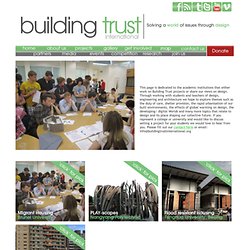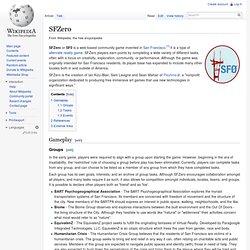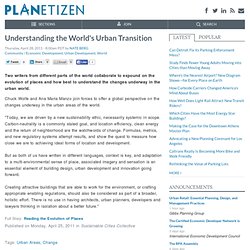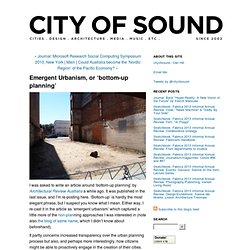

Ron Finley: A guerilla gardener in South Central LA. Research: Building Trust international - Building Trust in academic institutions. This page is dedicated to the academic institutions that either work on Building Trust projects or share our views on design.

Through working with students and teachers of design, engineering and architecture we hope to explore themes such as the duty of care, shelter provision, the rapid urbanisation of our built environments, the effects of global warming on design, the developing/ digital Worlds and many more topics that relate to design and its place shaping our collective future. If you represent a college or university and would like to discuss setting a project for your students we would love to hear from you.
Please fill out our contact form or email: info@buildingtrustinternational.org Below is a growing resource of research papers that we find interesting and would like to share you. If you have a piece of research you would like to feature here, contact us. A conversation on TED.com: What do organized communities achieve more efficiently than government? What could they achieve?" Private Public Space. What do pop-up shops and homelessness have in common?
SFZero. SFZero or SF0 is a web-based community game invented in San Francisco.[1] It is a type of alternate reality game.

SFZero players earn points by completing a wide variety of different tasks, often with a focus on creativity, exploration, community, or performance. Although the game was originally intended for San Francisco residents, its player base has expanded to include many other locales both in and outside of America. Street Skiing—AMAZING! [Weekend Watch] Often architects, developers and city planners try to sell their redevelopment’s with glossy brochures and vibrant mock ups.
![Street Skiing—AMAZING! [Weekend Watch]](http://cdn.pearltrees.com/s/pic/th/urbanism-diversity-disorder-74727044)
However, more often than not, these place turn out to either be dead, or sterile places. The problem isn’t always a lack of uses or diversity; rather it is that these places are often planned to the last window awning or flower bed. They lack the ‘messiness’ that make a city livable. The most vibrant cities I’ve lived in or visited share one thing in common. They are messy. Part of the appeal of messy urbanism is that it leaves room for future improvements in other words, it leave creates space for people to contribute to their neighborhood.
In The Economy of Cities, Jane Jacobs points out that the most economically vibrant cities are usually inefficient and impractical. Rooftops and Infiltration. THE MOVIE. We. Arundhati Roy - Share It. Don’t Occupy Wall Street—Transform It. Elos.
Social Commentators/Online Opinion. Understanding the World's Urban Transition. Chuck Wolfe and Ana Maria Manzo join forces to offer a global perspective on the changes underway in the urban areas of the world.

"Today, we are driven by a new sustainability ethic, necessarily systemic in scope. Carbon-neutrality is a commonly stated goal, and location efficiency, clean energy and the return of neighborhood are the watchwords of change. Formulas, metrics, and new regulatory systems attempt results, and show the quest to measure how close we are to achieving ideal forms of location and development. But as both of us have written in different languages, context is key, and adaptation to a multi-environmental sense of place, associated imagery and sensation is an essential element of building design, urban development and innovation going forward.
Emergent Urbanism, or ‘bottom-up planning’ I was asked to write an article around ‘bottom-up planning’ by Architectural Review Australia a while ago.

It was published in the last issue, and I’m re-posting here. ‘Bottom-up’ is hardly the most elegant phrase, but I suspect you know what I mean. Either way, I re-cast it in the article as ‘emergent urbanism’ which captured a little more of the non-planning approaches I was interested in (note also the blog of same name, which I didn’t know about beforehand). It partly concerns increased transparency over the urban planning process but also, and perhaps more interestingly, how citizens might be able to proactively engage in the creation of their cities. While it applies to Australian cities most closely, I hope the ideas here might be more generally interesting. Rebar Art & Design Studio. Fun urbanism: Group video game in a Madrid plaza. Basic Program of the Bureau of Unitary Urbanism (Kotanyi & Vaneigem) Constant's New Babylon: the hyper-architecture of desire - Mark Wigley.
Occupy as psychogeographic urbanism [draft 3] [Draft 5 is much longer and edited in many places, to make it a bit easier: # mostly unchanged, # changed, # new paragraph.]
![Occupy as psychogeographic urbanism [draft 3]](http://cdn.pearltrees.com/s/pic/th/psychogeographic-21812961)
Mass Moving, des Insoumis dans l’Art. Version française – Nederlandse Versie – English Version L’histoire d’un mouvement artistique né en Belgique et en Hollande dans la foulée de mai 68.

Composé d’artistes et d’ingénieurs, le groupe se définit par des projets et des actions éphémères. Le but de Mass Moving ? Sortir l’Art des musées et des galeries en investissant la ville et la rue, promouvoir l’importance de la terre et le concept de chaîne planétaire, faire appel à une dimension ludique et à la participation des spectateurs, dénoncer l’ordre bourgeois et les conventions établies. Le groupe se définit par des Actions réalisées à travers le monde. Quand les Mass-Movers réalisent que le fonctionnement du groupe ne correspond plus à leur idéal de départ, ils se sabordent en 1976 par un autodafé spectaculaire, détruisant les machines, brûlant les dessins, les photos, les films et les affiches.
Le film est illustré par de nombreuses archives d’époque. Sélection au Festival International du Film d’Art de Montréal 2007. A Journey to the worlds' sustainable cities / Brisbane to Bogota. Edible Brisbane: Public Fruit. Activismo 2.0 y empoderamiento ciudadano en red (II) Bienvenida sea la crisis económica si gracias a ella las sociedades democráticas asumen actitudes más participativas y conscientes de su condición, precisamente, democrática.

Los recientes acontecimientos de reivindicación social como el 15-M, la Primavera Árabe o la ocupación de Wall Street lo han puesto de relieve: los ciudadanos no quieren renunciar al papel como supervisores de la gestión de los gobiernos porque –en una democracia– el verdadero gobierno son los ciudadanos. El voto significa cada vez menos una acción aislada que sucede cada cuatro años y cada vez más un ejercicio de confianza previo a una actividad que será supervisada, en directo, y con derecho permanente a réplica por parte de la ciudadanía. Solo hay que recordar que en España una de las mejores formas de pulsar el debate colectivo de la campaña a las elecciones generales 2011 fue siguiendo su flujo de hashtags en Twitter. Queremos saber Alimentando el procomún Crowdsourcing para innovar en lo público. Five Things Governments Can Do to Encourage Civic Startups « Civic Innovations. 2012 is shaping up to be the “Year of the Civic Startup.”

With the growth of the open government movement and more and more governments embracing open data, we see an increasing number of useful civic applications being developed. Every weekend hackathon spawns multiple projects that could potentially live on as a successful venture or company. Can Karaoke Transform Public Space? This post is also available in: Chinese (Traditional) Government agencies and marketing bureaus across the globe strive to find ways to get people into parks and using public spaces.

Some spend millions with extravagant firework spectaculars, while others import international music acts or host an almost continuous string of farmer’s markets and craft fairs, many of which fail to deliver a certain je ne sais quoi. But in a not-so-pristine park in Berlin, an Irish guy named Joe draws crowds of more than 3,000 people … with karaoke. Which got me thinking, can karaoke transform our public spaces? It seems an odd thing to say, but yes, I believe it probably can.